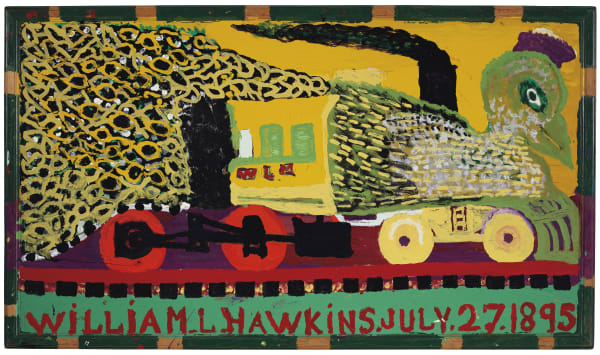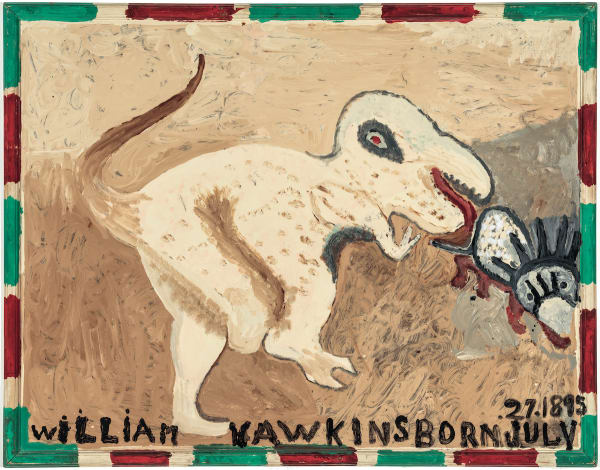William Hawkins American, 1895-1990
William Hawkins lived most of his life in Columbus, Ohio, after fleeing his Kentucky home state in his twenties to avoid a shotgun wedding. In his youth on a rural farm in Kentucky he developed a knowledge and love of animals, which he later expressed in many of his paintings. In Columbus he worked a variety of jobs, many of which took him across the country as a traveling salesman. He took black-and-white photographs as he drove through, and many of these served as inspiration for his paintings. He was drawing and selling his work as early as the 1930s, but it was not until the mid-1970s that he began painting in the style for which he is best known, creating many works from then on in spite of illness and advancing age.
The main source of Hawkins’s inspiration were the print media of his time. As Lyle Rexer has described it, “The pictures in magazines and newspapers, which he hoarded in a suitcase and carefully sorted through . . . opened up the world and acted as a catalyst. . . He felt that these photographs could be made more interesting, pretty, exotic by painting, and only by painting. He also knew they could save him a lot of trouble, substituting for labor-intensive elements he had trouble rendering—faces, for example.”
At first, Hawkins painted in primary color enamels on plywood; later he worked on Masonite, which he preferred because it did not “suck up the paint.” He liked using a single threadbare brush and pouring and dripping paint, often directly from the can, and tilting the surface to let the paint flow across it so that he could, as he put it, “watch the painting make itself.” Hawkins’s primary subject matter includes common, exotic, extinct, and semi-fantastical animals; cityscapes, landmarks, and prominent buildings; and religious and popular culture iconography. Along with collaging photos into his work, Hawkins also added wood, gravel, sand, cornmeal, and found objects, and he often painted decorative borders around his works, very frequently including his name and birth date and place in large handwriting—a poignant feature, as Hawkins could scarcely read or write.
It was not until his friend Lee Garrett entered one of his paintings at the Ohio State Fair in 1982, where it won first prize, that Hawkins received recognition for his work. In his late eighties by then, Hawkins continued to work immensely prolifically. By 1983 Ricco/Maresca Gallery represented him, launching his career nationally and internationally. In 1989 Hawkins suffered a stroke from which he only partly recovered and a few months later he died. Hawkins’s work is in the permanent collections of, among others, the Milwaukee Art Museum, the Brooklyn Museum, the American Folk Art Museum (New York), the Philadelphia Museum of Art, the High Museum of Art (Atlanta), the Columbus Museum of Art, and the Smithsonian American Art Museum (Washington, D.C.). In 2018 William L. Hawkins: An Imaginative Geography, an exhibition including sixty of Hawkins’s most important works and an accompanying catalogue, opened at the Columbus Museum of Art and traveled to the Mingei International Museum (San Diego), the Figge Art Museum (Davenport, Iowa), and the Columbus Museum in Georgia.
-
 Peacock Express, ca. 1982
Peacock Express, ca. 1982 -
 Yellow Stegosaurus, c.1985-87
Yellow Stegosaurus, c.1985-87 -
 Paris, 1992
Paris, 1992 -
 White Elephant, 1989
White Elephant, 1989 -
 Romance, 1987
Romance, 1987 -
 Willard Hotel, 1987
Willard Hotel, 1987 -
 Adoration of the Wise Men, 1985
Adoration of the Wise Men, 1985 -
 Deshler Hotel #3, 1985
Deshler Hotel #3, 1985 -
 Great Wall of China, 1985
Great Wall of China, 1985 -
 Quaker Square Hilton, 1985
Quaker Square Hilton, 1985 -
 Bat Man, 1984
Bat Man, 1984 -
 Tower Motor Inn, 1984
Tower Motor Inn, 1984 -
 Untitled (Yoda), 1983
Untitled (Yoda), 1983 -
 Rhino, 1981
Rhino, 1981 -
 Dinosaurs
Dinosaurs -
 Magical Toad (Kin Frog)
Magical Toad (Kin Frog)
















